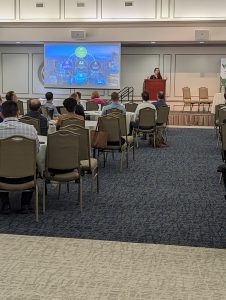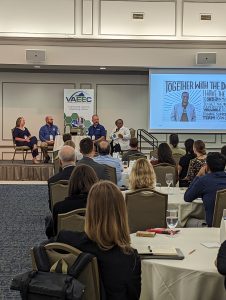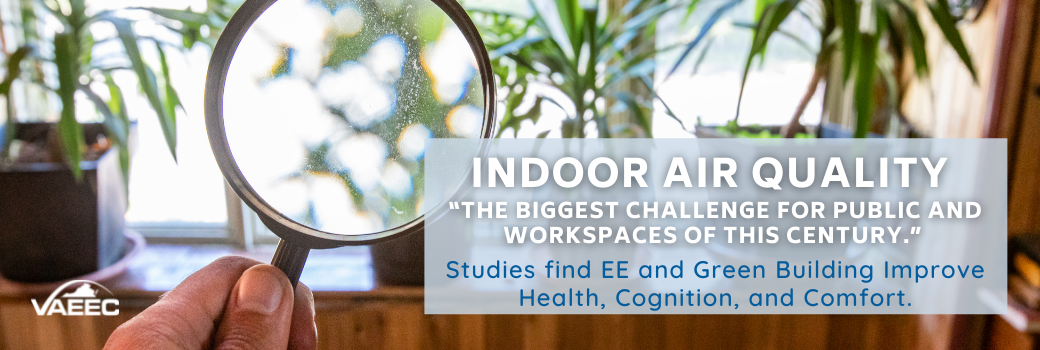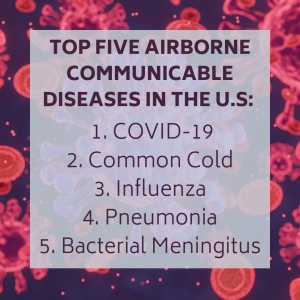2023 Energy Efficiency Forum Recap
The Commonwealth’s energy efficiency community gathered on October 4th and 5th for the VAEEC’s annual Energy Efficiency Forum. Thank you to our sponsors, speakers, award winners, and attendees for making this event a great success!
Day one was fully virtual in an effort to make the event more accessible and to provide a diverse array of speakers from across the country. It consisted of a keynote address and four breakout sessions:
Keynote Address: Dr. Bob Holsworth is a Managing Partner at DecideSmart, a consulting firm that provides strategic solutions for complex challenges. Bringing decades of experience in the political sphere, he provided an analysis of Virginia’s election landscape and what that can mean for the Commonwealth’s clean energy future.
“Regardless of the election results, there will be a slate of new legislators. Education will be important.” – Dr. Bob Holsworth, DecideSmart
Technology: What’s New and What’s Next?: The panelists in this session discussed heat pumps and heat pump hot water heaters, demand response AI programs, and data center cooling technologies. The discussion helped to sift facts from fiction and suss out what the on-the-ground realities are, and what we can look forward to in the future. Speakers included Richard Anderson (Siemens), Millie Knowlton (CPower), Andrew Grigsby (Viridiant), and Adam Sledd (Dominion Energy Innovation Center, moderator).
“The question we try to answer is, how can we leverage technology to help humans?” – Richard Anderson, Siemens
Implementing Green Building Policies in a Dillon Rule State: As a Dillon Rule state, Virginia localities are limited as to what they can and cannot mandate. However, jurisdictions are finding creative ways to make progress happen in their communities. Join speakers from Arlington County and the City of Alexandria as they discuss their green building policies and programs, and how they have established minimum standards for new development and major renovations. This was an interactive session where audience members were encouraged to engage with speakers to learn how to implement their own green building policies. VAEEC Board member, Bill Eger (Arlington County), moderated the panel, which included Arlington County’s Paul Roman and the City of Alexandria’s Valerie Amor, and Robert Kerns.
“The idea of ‘business as usual’, ‘we’ve always done it this way’, is one of the biggest challenges in getting developers on board. We’ve got to embrace new ways of doing things to implement green building strategies.” – Valerie Amor, City of Alexandria
Rural Energy Efficiency: No Town Left Behind: According to the Department of Housing and Urban Development, 88% of Virginia is considered rural. However, this population is often overlooked in energy efficiency policy and programs. This panel focused on how to reach rural communities and what opportunities are available to them. Speakers included Adia Holland (U.S. Department of Agriculture), Lance Hostutler (Optimum Building Solutions LLC), Will Payne (Energy Delta SWVA), and VAEEC Board Vice Chair, Leigh Anne Ratliff (Trane Technologies, moderator).
Case Study Session: Green Building Certifications: Green buildings are environmentally responsible, resource-efficient, and create healthier, more comfortable spaces. Numerous certification systems exist to assess a building’s sustainability and designate it as a green building. This case study session was designed for attendees to benefit from shared knowledge and experience through presentations and audience Q&A. The certifications featured included EarthCraft, Zero-Energy Ready, and Pearl Certification for single-family homes, multifamily buildings, and whole communities. The session was moderated by VAEEC Board member, Bryna Dunn (Moseley Architects), and speakers consisted of Stephen Dareing (Viridiant), Jay Epstein (Healthy Communities), and Casey Murphy (Pearl Certification).
“I want to make low-performing homes the green avocado refrigerators of 2023.” – Casey Murphy, Pearl Certification
After the virtual day wrapped up, attendees had the opportunity to join one of two regional happy hours to further connect with other energy efficiency professionals. This was the first time we have offered a regional happy hour in conjunction with a virtual event. What a great way to spend 2023 #EnergyEfficiencyDay!
Attendees gathered in person for day two at the University of Richmond Jepson Alumni Center in Richmond. The day began with an opening presentation from Executive Director, Chelsea Harnish. Attendees were provided with updates on the organization’s 2023 accomplishments and our 2024 priorities, as well as an overview of the Commonwealth’s energy efficiency industry. The day also included a keynote address, a plenary panel, the eighth annual Virginia Energy Efficiency Leadership Awards ceremony, and an on-site reception.
 Keynote Address: Attendees were then treated to a keynote address from Dr. Karma Sawyer, Director of Electricity Infrastructure & Buildings (EI&B) Division at the Pacific Northwest National Laboratories (PNNL). In this role, Dr. Sawyer is responsible for shaping and managing a vision and strategy to ensure that PNNL addresses the U.S. Department of Energy’s most important energy efficiency, clean energy, and electricity infrastructure challenges. She discussed energy efficiency as it relates to cutting-edge research, building codes, market transformation, federal funding, and emerging technologies, with a specific focus on equity.
Keynote Address: Attendees were then treated to a keynote address from Dr. Karma Sawyer, Director of Electricity Infrastructure & Buildings (EI&B) Division at the Pacific Northwest National Laboratories (PNNL). In this role, Dr. Sawyer is responsible for shaping and managing a vision and strategy to ensure that PNNL addresses the U.S. Department of Energy’s most important energy efficiency, clean energy, and electricity infrastructure challenges. She discussed energy efficiency as it relates to cutting-edge research, building codes, market transformation, federal funding, and emerging technologies, with a specific focus on equity.
 The Energy Efficiency Workforce Initiative: A Holistic Path to Workforce Development: After a break for networking and snacks, attendees came back together for the plenary session focused on the VAEEC’s Energy Efficiency Workforce Initiative. For the last two years, the VAEEC has been developing the EEWI to address Virginia’s growing workforce needs. This panel provided updates from staff and our expert partners as we build out each piece of the puzzle – recruitment, training, placement, and sustainable retention. Speakers included Laura Hanson (Tidewater Community College), Phil Hull (CHP Energy Solutions), Michael Flanagan (Quick AC Quote), Crystal McDonald (D.C. Sustainable Energy Utility), and Rebecca Hui (Virginia Energy Efficiency Council, moderator).
The Energy Efficiency Workforce Initiative: A Holistic Path to Workforce Development: After a break for networking and snacks, attendees came back together for the plenary session focused on the VAEEC’s Energy Efficiency Workforce Initiative. For the last two years, the VAEEC has been developing the EEWI to address Virginia’s growing workforce needs. This panel provided updates from staff and our expert partners as we build out each piece of the puzzle – recruitment, training, placement, and sustainable retention. Speakers included Laura Hanson (Tidewater Community College), Phil Hull (CHP Energy Solutions), Michael Flanagan (Quick AC Quote), Crystal McDonald (D.C. Sustainable Energy Utility), and Rebecca Hui (Virginia Energy Efficiency Council, moderator).
Energizing Efficiency Campaign & Virginia Energy Efficiency Leadership Awards Ceremony: Next, we had the honor of hosting our eighth annual Virginia Energy Efficiency Leadership Awards ceremony. We started off by highlighting the 18 submissions to our inaugural Energizing Efficiency Campaign. Case studies can be viewed for each of these participating projects or programs on our 2023 Energizing Efficiency Campaign page. From these 18 submissions, five were chosen by the VAEEC’s Education & Events Committee to receive a 2023 Virginia Energy Efficiency Leadership Award for their incredible energy efficiency contributions. For information on each winning project or program, visit our 2023 Awards page.
The event concluded with an on-site networking reception sponsored by Dominion Energy. It is always a pleasure to connect with many of our members and others in the industry face-to-face, and this was no exception.
Thank you to our sponsors, speakers, award winners, and event attendees for making this one of our best events to date. Click here to view photos of the event. Additional event information, including speaker biographies and sponsor features, can be found in the event program.
Event attendees will receive recordings for each of the four breakout sessions in the post-event email. Presentation PDFs can be viewed at the links above.


